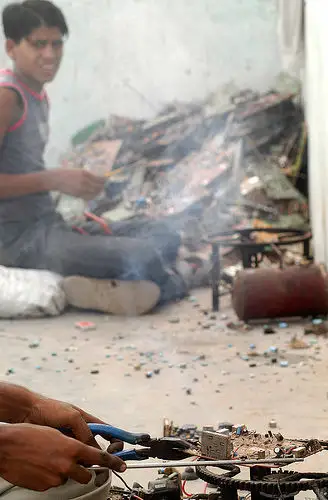Blog action day: E-waste, the downside of the growing web
 Today is blog action day and this year’s topic is environment. Thousands of bloggers will devote their writing skills to create more awareness to our threaten environment. I decided to write about e-waste (electronic waste). As Internet grows everyday, so does the demand for electronic equipment that preserves and extends the access to the Internet. Unfortunately, personal computers, laptops and mobile phones do not only have heavy toxic parts, their life span is mostly very short. The waste ends in places where people cannot protect themselves from the toxins, but have to recycle them as an income. Every year, hundreds of thousands of old computers and mobile phones are dumped in landfills or burned in smelters.
Today is blog action day and this year’s topic is environment. Thousands of bloggers will devote their writing skills to create more awareness to our threaten environment. I decided to write about e-waste (electronic waste). As Internet grows everyday, so does the demand for electronic equipment that preserves and extends the access to the Internet. Unfortunately, personal computers, laptops and mobile phones do not only have heavy toxic parts, their life span is mostly very short. The waste ends in places where people cannot protect themselves from the toxins, but have to recycle them as an income. Every year, hundreds of thousands of old computers and mobile phones are dumped in landfills or burned in smelters.
Some statistics
- Electronic waste represents 2 percent of America’s trash in landfills, equal to 70 percent of overall toxic waste (wikipedia)
- It is estimated that the US alone exports 80 percent of its e-waste to China, India and Pakistan. (treehugger)
- Germany has a yearly dumb of over 1 million tons of e-waste, which is over 13 kilos per person.
- Only 11% of PCs are recycled; the percentage for televisions and mainframes recycled is even lower. (ITfact)
The growing e-waste has consequences especially on the poor because all sorts of electronic waste is legally or illegally dumped in developing countries. It is not only computers but also vacuum cleaners, cables and all other sorts of appliances and electronic equipment. Greenpeace campaigns against the producers of laptops requesting them to use less toxic parts and obliged them to offer a recycle mechanism. Electronic waste is a valuable source for secondary raw materials if treated properly. But the recycling of e-waste is done very basically with tremendous health risks for workers (check out the photo from Greenpeace India).
Most e-waste goes to Asia, especially India and China, but growing amounts go to Africa. Here are some sources, which describe the difficult situation in different countries:
- E-waste In India: A Growing Industry & Environmental Threat
- Kenya Faces an E-Waste Time Bomb
- E-waste poisoning in Nigeria
- E-Waste is killing Ghanaians slowly
- E-waste Recycling is Serious Health Threat in China
Check out the following video to see how drastic the situation is and find out that in the US it is unfortunately still legal to export e-waste to other countries. E-Waste: Dumping on the Poor (Asia Society)
``And last but not least, here you can find some tips to avoid e-waste: Green E-Waste Tips
